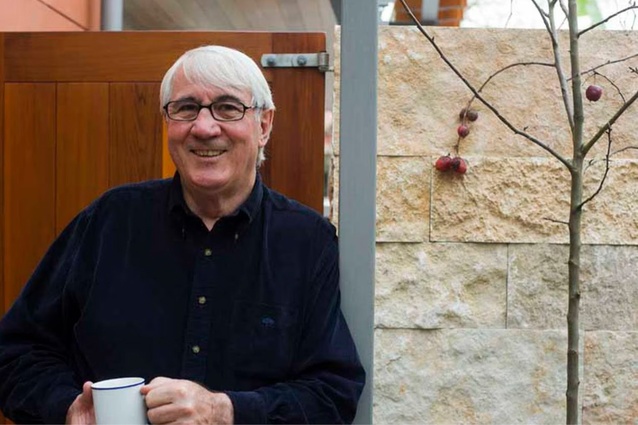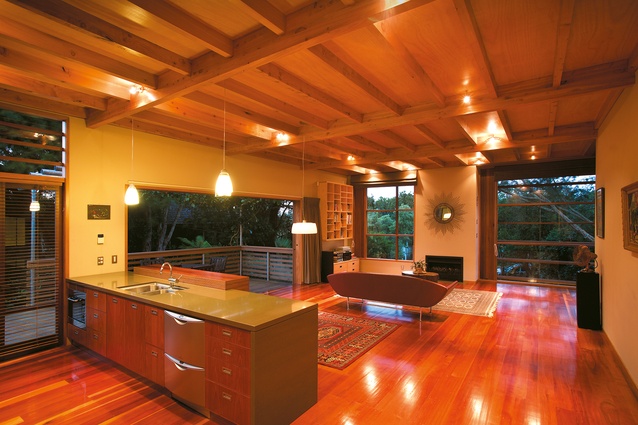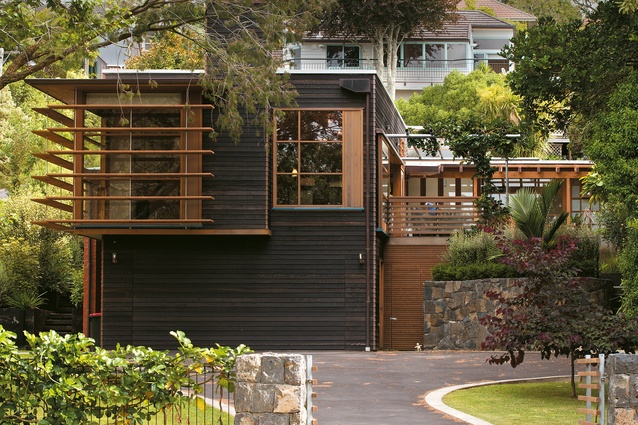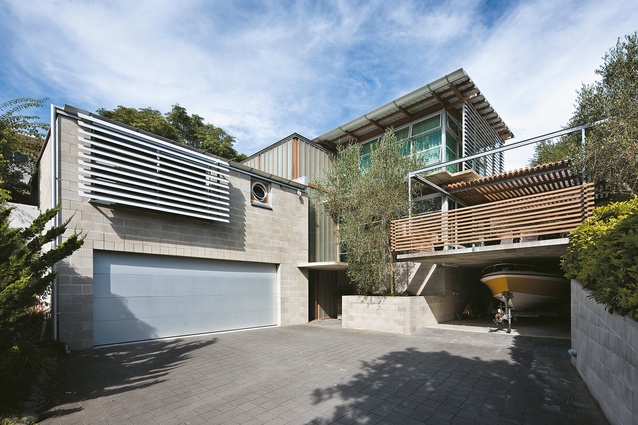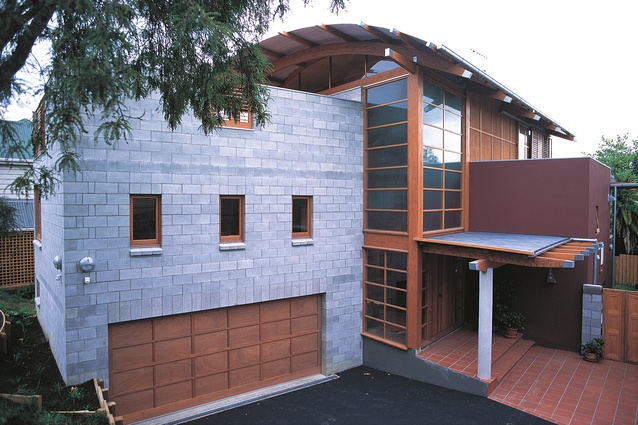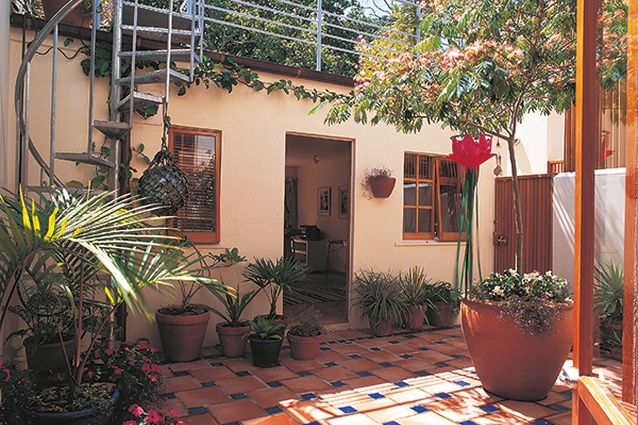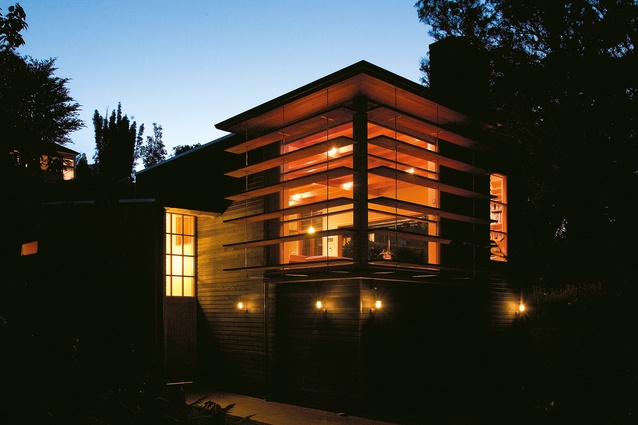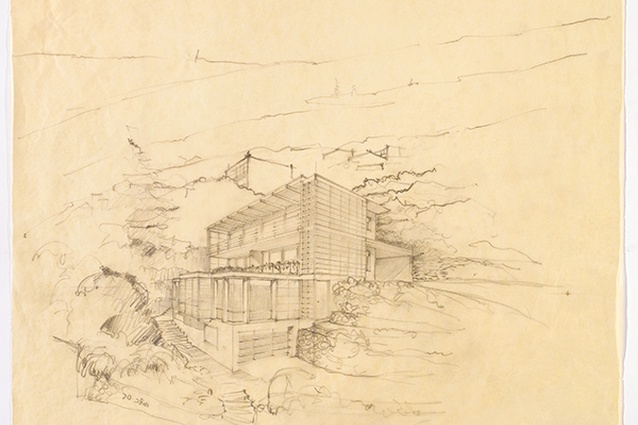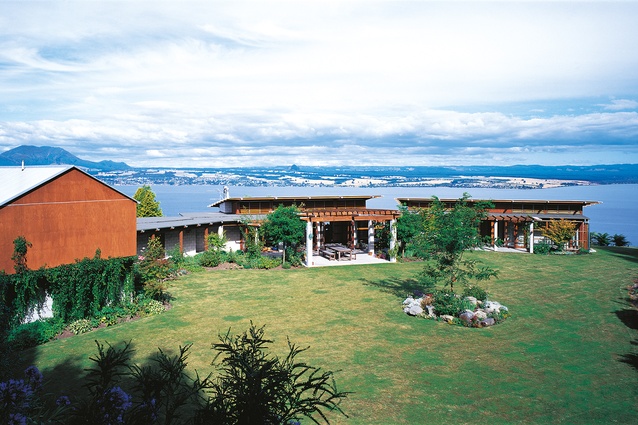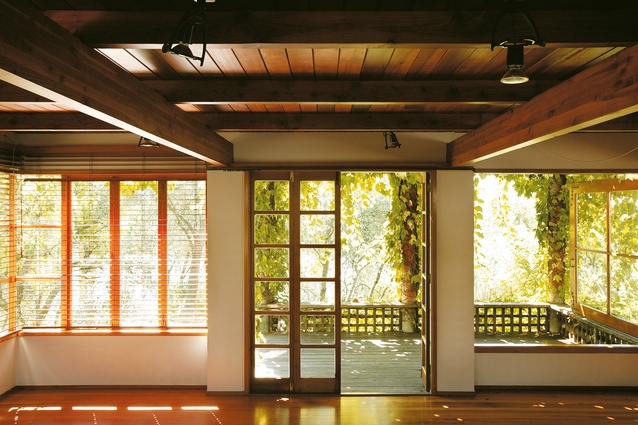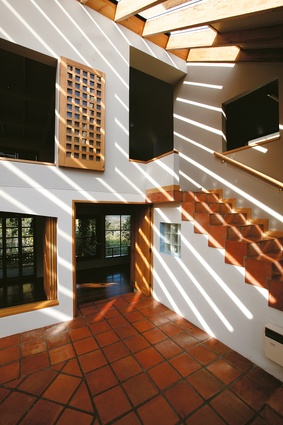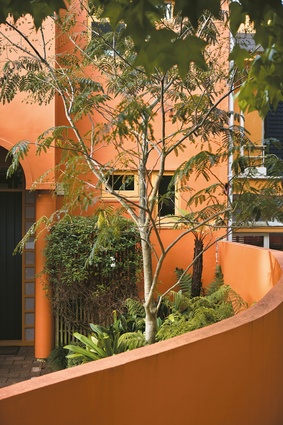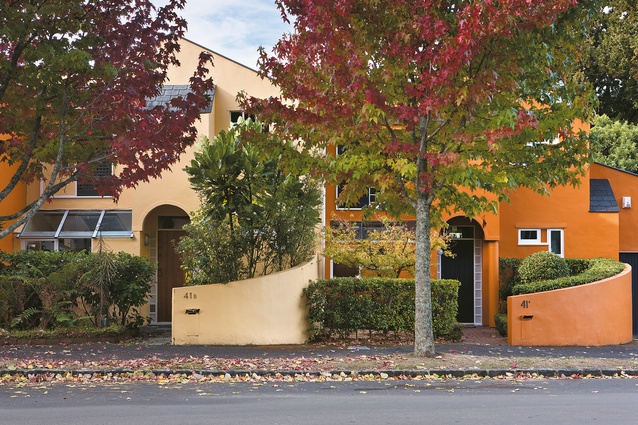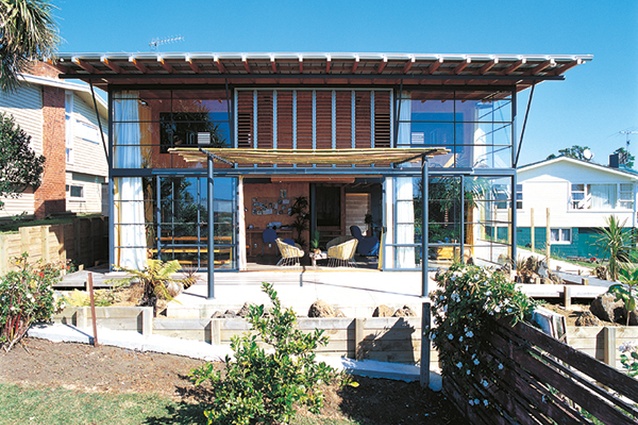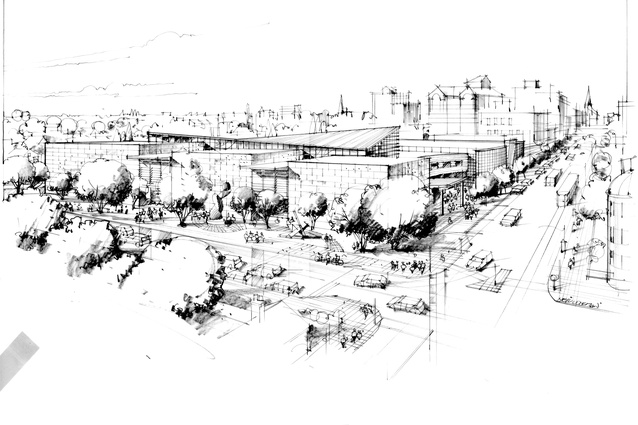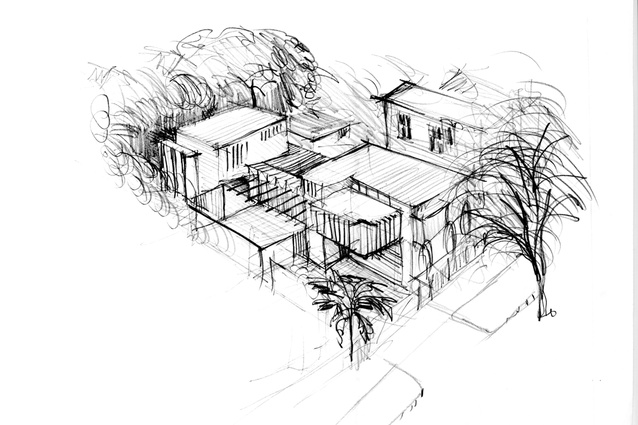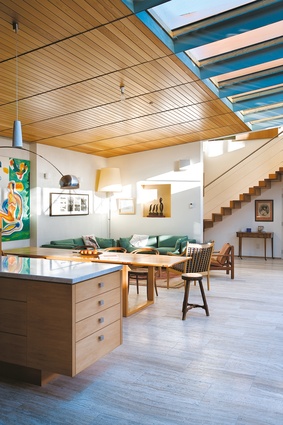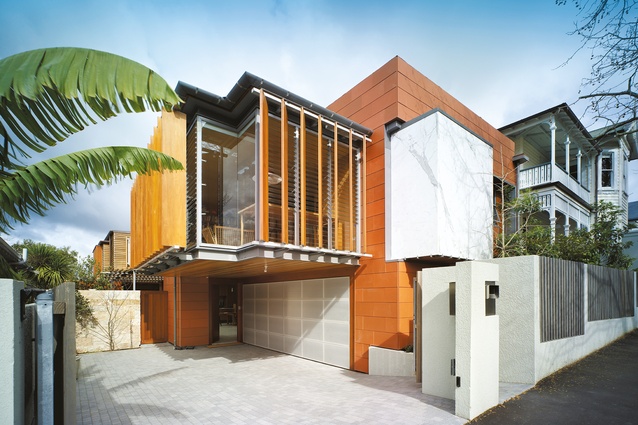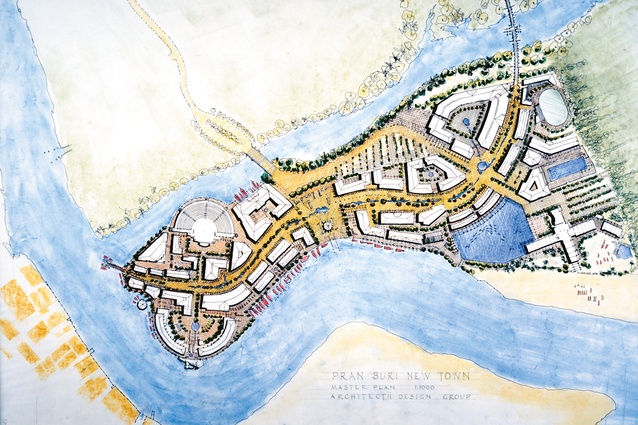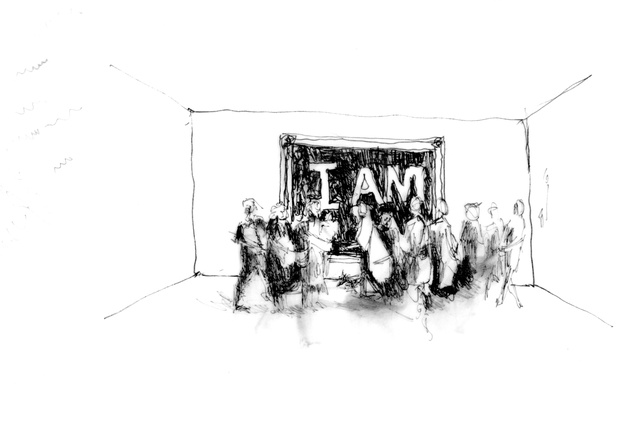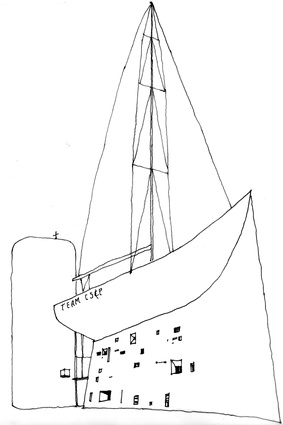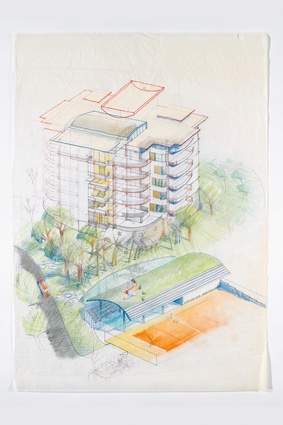Marshall Cook: 2006 interview
The late Marshall Cook was awarded the NZIA Gold Medal in 2010, the highest single honour the institute bestows. In this article first published in Houses from 2006, Marshall talked to the then-editor John Walsh about his life in architecture.
Marshall Cook started his own practice in Auckland in 1967. In the decades since he has worked in the United States, Thailand and Japan, taught in the UK and New Zealand, and built a reputation as one of this country’s most significant residential architects. John Walsh talks to him about his career and his profession.
John Walsh: Let’s start at the beginning. Where are you from?
Marshall Cook: Napier. I’ve always considered it a privilege to have grown up in a small town in New Zealand. And Napier was a very architectural town – people were aware of the architecture, and of the architects. The buildings were well crafted. My own school, Napier Boys High, was a very fine piece of architecture. It was an interesting school because it offered a huge variety of courses. There was a school farm and workshops. You could do everything – carpentry and metalwork and arts, accountancy, history, geography, Latin … you could do what you liked.
What did your parents do?
My father was a cartographer for the Department of Lands and Survey. He was also the historical curator at the Hawkes Bay Art Gallery and Museum. He did that part-time – it was a sort of hobby occupation. So I grew up in a house full of aerial maps and photographs … Early on, I had some knowledge of geography and a strong sense of landscape. My father was very interested in architecture. He knew all the architects in town, and he had done surveying work for many of them. My mother came up from Wellington on the day of the Napier earthquake [3 February 1931] and lived in Tent City immediately after. She married my father shortly after.
Was Napier an affluent town?
It was a port town, not as affluent then as somewhere like Hastings. The port was a working-class area and the suburbs were sort of middle class but everyone would go to town on Friday afternoon. School kids, parents, farmers … The town was chocker on a Friday. The main street, which is a couple of hundred yards long, was a very social meeting ground. I still think that most cities in New Zealand can only survive one major area of interest and in Napier, it was the main street.
When did you decide to go into architecture?
I was interested in typography when I was young. Right through school, I was primarily sort of following that particular course, but the director of the local museum, who had a strong association with the Bauhaus, introduced me to modern architecture. I worked in a local architect’s office over the school holidays, and I used to visit John Scott, with whom I later worked – there was a very good John Scott house down the road from where we lived. I was aware from the middle of my high school years that I was going to be an architect rather than a typographer, although I still retain a tremendous interest in typography. I still look at books and magazines, and I know the names of most of the typefaces.
And then to Auckland?
Then straight to Auckland and I never really went back. I never even went back mentally once I’d come to Auckland and realised that’s what a city was all about. I started at the Auckland Architecture School in 1959, took four years off in the middle of the course and then came back and finished in 1966.
What did you do in the middle years?
I worked. I had trouble with some of the subjects at the School – maths and science especially … and so I went to work for Wilson and Juriss, which was the old Group Architects. I also worked for John Scott and Lillian Christall. By the time I left the School, I’d already had three years of good practical experience. When I went back to the School I found that I had a different approach to the subjects I had trouble with … or perhaps they marked me a bit easier. In my first year out of the School, I was a teaching fellow there. In August 1967 I set up practice on my own – I had enough work and experience to do so. At Wilson and Juriss I’d been doing full sets of working drawings. Most of the work was pretty complex, and as a consequence, I learnt how to assemble a building plank by plank, post by post, beam by beam. Ultimately, the important thing for me was becoming very aware of the distinct plan form and social order of the houses. I think that’s probably the thing that influenced me most working there. I got an understanding of how a house works from the inside out. The outside is just an outer skin – the full range of human activities and the rituals of domesticity are all contained within that skin.
Was anyone at Architecture School as influential as the people in the practices you worked for?
There were some important people at the School, but because of the nature of the students of the day and the nature of the relationship with the teachers – it was that whole hippy era – you didn’t really take a lot of notice of them, except when you needed marks. On the whole, it was a fairly rebellious School in the mid-sixties. The students were rebelling against post-war conservatism – in architecture, it hadn’t really been broken down. In the profession it had, but not in teaching. Between the time I started at the School and the time I finished, there was a change. There were new ideas and the Beaux Arts teaching positions had gone. We weren’t really as aware as we should have been of the quality of some of the teachers. For example, Vernon Brown was a teacher who never put a word wrong and was always spot on. It wasn’t until my final two years at the School that people like Bill Wilson came to teach and a lot of the older ones dropped out.
So, by the end of your studies, it was quite a good time to be at the Auckland School?
Yes, it was a good time. They’d dropped the old articles, they’d changed to a degree course from a diploma course, and registration was becoming compulsory, so it was the last chance for a lot of draughtsmen in practice to get in and qualify. We had people from about 16 to 35 and for the first time, there was a good proportion of women in the class. The School was full of people who knew a hell of a lot and could teach the other students a lot about construction and so on. People were really opening up to the world of architecture elsewhere. We were very aware of what was happening in the Scandinavian countries … and there was the whole Pacific Rim architectural genre … The Japanese and the modern Americans and Australians like Robin Boyd were doing wooden houses and the people I worked for were doing just the same. It was a turning point in architecture in terms of the change in teaching and the change in buildings.
What did people want to do when they left the School? What was the career path then?
It was interesting because there were no big practices that produced small works. All the small work was being done in small practices and when we set up in practice in 1967 we were the first new practice in Auckland, in the city that is, in ten years. When we started we were sort of part of the new wave and a lot of other firms then came along.
Did you go into practice by yourself?
I started working out of an engineer’s office picking up the crumbs, and that turned into something profitable. And then we opened an office next door to them in a small corridor, and then we took over another office next door and then another one. We ended up having the back half of the building. My first partner Terry Hitchcock had come from an established practice with a lot of clients. There were seven or eight of us – quite a large practice for a start-up company and we had a huge variety of work, including some large buildings. Peter Sargisson joined us when he returned from working overseas and the partnership remained that way until 1990. Most of the other practices that were established about then had been set up on government or local authority work – there was a lot of rebuilding of schools and hospitals and art galleries and museums, and borough offices, and power boards. The firms that did that work were entirely different structures from ours. We were essentially doing design and build for engineers, and houses – substantial numbers of houses. It wasn’t unusual for us to have between 60 and 100 projects a year. That meant it was a seven-day-a-week practice.
Where were these residential clients coming from?
A lot of them were young professionals, many of them newly married. The ones from out of town were farmers – young farmers taking over the family farm, building additions. You can look back now and realise that we were probably doing a complete set of working drawings in a month, plus all the design work. There were no standardised details and no standardised approaches. You had to approach every problem from scratch. For that first eight years or so it was really a matter of working as hard as you could – not exactly churning the handle, but certainly trying to get stuff through as quickly as you could.
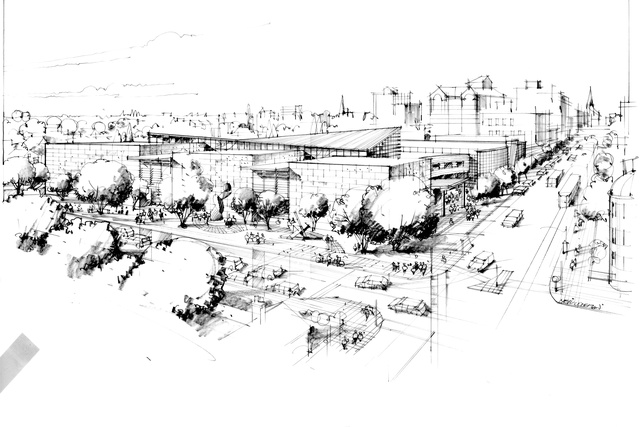
Was there a sense that you were working in a ‘New Zealand’ way? For example, you said you’d been influenced by The Group.
Some of our early work was very much part of that Group Architect tradition – its sort of planning and construction technology. But there was a sense that we were changing or extending those original ideas … I suppose the major issue was that there was a slight change in the way the contracts were run and managed. A lot of our stuff was negotiated. The relationship with the building contractor was very important. You had to trust the builder.
Your initial push took you well into the seventies.
In the mid-seventies, I went to England and taught for three years. I taught at North East London Poly [now the University of East London] and at Brighton Technical College [now the University of Brighton]. I had what was called a Burnham Contract. You literally worked wherever you were sent. I worked two days in Brighton and two days in North East London and on Wednesdays I’d go to wherever I was contracted to work. There was a central organisation but you listed your area of expertise, which in my case was timber construction, which was very popular at the time.
For me, it was a great time. Architecture as a profession then had two halves. There was a conservative right-wing half and a liberal left-wing half. One of the schools I worked for had right-wing staff and left-wing students and the other was full of left-wing staff and right-wing students. So it was pretty lively. I worked with people like Raymond Briggs, the illustrator. They were jolly people. The architectural educational system in England was undergoing major change because of the huge influx of students from countries that didn’t have schools of architecture. There were a lot of students from Africa, for example.
And then back to New Zealand?
We returned about 1979 but I was only back here for a year before we started doing a lot of work in America. That lasted for eight years.
What sort of work were you doing in America?
Villages, essentially – ski resorts, ski villages, apartments. We got involved through Graeme Woodhouse, a surveyor from Te Awamutu who had become an urban planner in America. We were based in Vail, Colorado, and we’d go up and spend whatever period was needed to do the project. At the end of each stint up there, the partner could go away with his wife for two or three weeks, paid for by the contract, before coming back. You could travel almost anywhere in that time and have a good look around … We spent a lot of time overseas – in Europe – looking at the sort of stuff we were trying to perfect and develop.
How did you get on with the local architects? Did you have to work with any of them?
We did the design work and they did the working drawings. We would go up and work in with them during the working drawing stages in the office. We’d spend a month or six weeks in an architect’s office until the job was completed or at least the back of it was broken, and the drawings were to the client’s requirements. Some buildings started out two storeys and ended up being eight, and some started out a hundred yards long and ended up four hundred yards.
We were miles ahead of the Americans in terms of urban planning and ideas and principles – too advanced for most of them, they were very conservative. After a while, though, the locals caught up with what we were doing. The people who picked up the drawings would take them away and read them and tell the clients ‘Well, we can do this cheaper and better next time’. It took them about eight years to tumble to it.
All the time you were keeping the practice ticking over here?
Yeah. It was the eighties – who remembers much about that? We finished in America – once the locals had overtaken us it was impossible to get back in. Anyway, by that stage we’d done 15,000 beds and had almost done the market in. We came back home but were soon invited to design a project in Japan – another village. It was based on the thinking that Japanese inner cities were becoming overcrowded and a lot of young people with children were living with their parents in the same houses, which was difficult. Their option was to build out of town and there were no schools or facilities. An idea for a new sort of crafts-based town emerged. People between 45 and 65 would have the ability to work to pay off a mortgage on a new house, while older couples would expect to be mortgage-free.
The intention was that there would be craft workshops … the old people would have something to do and could make money from spinning and silk weaving and painting and pottery and wood carving. There’d also be things like a golf course and a country club. We worked on that for three years. country club. We worked on that for three years.
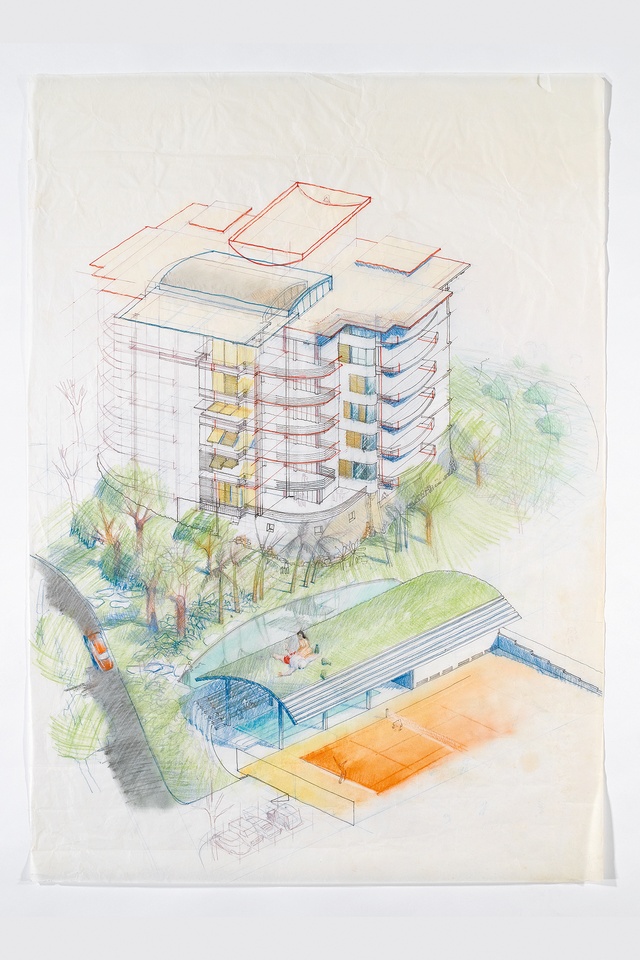
It’s very unusual for a New Zealand architecture practice to be doing offshore work like this. It must have been rewarding personally as well as professionally.
It was. Due to the nature of our practice, we were firmly cast in the domestic mold, and we weren’t getting bigger projects. So the work in Japan was a way of using the urban design skills that we’d developed in America. And when Japan finished we went and did exactly the same thing in Thailand. We had a practice in Thailand for eight years – it was all coastal resort stuff. Thailand was demanding. One year I spent eight months up there in total. It was pretty hard but again it was an opportunity to do larger scale.
All this offshore work must have helped you weather the nineties recession in New Zealand.
We didn’t notice it. It had no effect on the practice whatsoever. For us, the overseas work was a relatively good income producer, but it did come at a tremendous expense. Consequently, it wasn’t highly profitable but everyone was paid.
By the mid-nineties, your practice had withdrawn from foreign work and returned to focus on work here.
In Thailand, the complete collapse of the baht meant that all of our clients were in retreat mode. Most of the projects we had worked on in the last two years were either cancelled or the land was sold. Some big stuff that we worked on, in competition with other companies – like the Bangkok overhead rail system – is still going ahead using our plans. But most of the other big projects were cancelled and we were paid up. We were very lucky when we got out of Thailand – we literally cashed our last cheque the day before the bottom fell out of the baht … I now realise the amount of time and energy that working offshore can take. It’s not so much the work that’s exhausting – it’s the time wasted at either end, clearing up to leave and clearing up to return. It’s a good couple of weeks out of your life. Back here I mainly got involved in individual houses and multi-unit housing and resorts. I spent a lot of time working on stuff that was more than one house.
You developed considerable urban design experience in the US and Asia. Have you been able to do similar work here?
Not really. Don’t forget, everyone thinks New Zealand is a big place, it isn’t … We worked for a few years with the Auckland Waterfront Advisory Group [AWAG]. But any of these schemes have got a short life as ideas and certainly in New Zealand most of them have a very short life. They get bashed up against what’s misleadingly called ‘reality’… The way it’s going, the waterfront will never offer anything to Auckland more than what it’s offered now.
In New York, especially after the New York Twin Towers competition, they say all competitions are in five parts. The first part is the best idea, the second part is supposed reality, the third part is the developer’s ideas, the fourth part is the city’s reality and the fifth part is what was going to happen in the first place, which is just a whole lot of new buildings. It happens like that here, too. AWAG came up with a lot of really good ideas about making a sort of canal development and reintroducing water into the development – not really a brave idea but an essential idea to open that big block of land to the harbour. But it looks like it’s not going to happen …
To return to your residential work, the mainstay of your practice now. When you look over your career is there a pattern to your progress?
Well, there is always a pattern. Jobs seem to go in a series, or ideas seem to go in a series. You sort of work out one set of ideas and then you pick up another, whether it’s about the use of materials or the evolution in the social management of houses. Nowadays, really, houses are like baches in the city. A good city house is like a small bach, whereas a bach is more like a large city house … What I think has happened is that there’s a much more open relationship between parents and children and there are differences in the ways families occupy houses. There’s a difference in the amount of space that kids have, and how it’s divided … and it’s reflected in the planning.
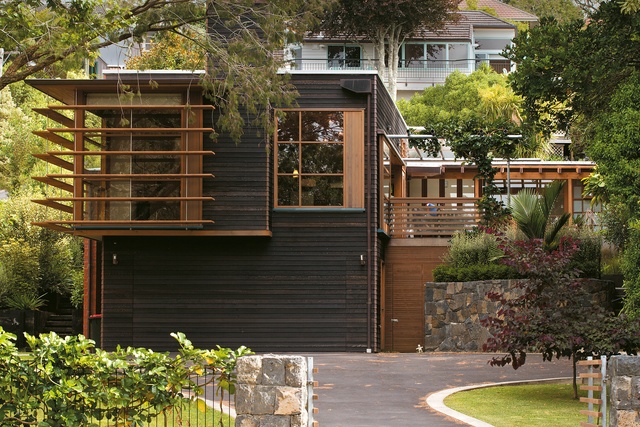
Can you design a house to last now? Perhaps it’s not possible for a house to serve a client for thirty years or so.
Well, people do sell and move on. I’ve just done it myself. You outgrow the family home. In our case, there was a whole wing that was empty and I hadn’t visited for six months. So you ask ‘Why the hell have we got all this space?’ … What happens to a house, if it’s set up for a particular type of family, which is to say a rather typical middle-class family, is that it can survive two or three decades of that family type before there are shifts. Most of the current shifts in residential architecture seem to be related to the business of how privacy and security are perceived in houses – kids wanting more privacy, and parents worried about security.
There are a few apparent contradictions here, aren’t there? The urban house becomes bach-like and the ‘bach’ becomes more house-like, and then there’s the predilection for the transparent house at a time when there are increasing concerns about privacy and security.
What’s interesting is the relationship between the politics of the country and the way that houses and to a certain extent buildings in general are put together. During years of conservative governance, you end up with a lot of very conservative people, and with houses that are all walls and barricades and fences. During years of liberal government, not only are architects so busy they can’t think – there are all sorts of social and infrastructural projects – but suddenly people open up. There’s a loss of insecurity and there’s a lot more optimism. Consequently, there’s a looking to the new rather than a looking back to the old. Under periods of liberal government, architecture develops quite a lot … The business of the transparent house is an ultimate expression of that. A lot of domestic rituals require privacy, but privacy is not always required. I sort of like the notion that a house is open to the city and the city is open to it.
The received wisdom is that the current default position of prominent New Zealand architects is a kind of neo-modernist minimalism, and there seems to be some reaction to this – a resistance to being told that you will get a particular type of house that demands a certain lifestyle. Do you have any opinions about this?
Well, I think there’s a whole generation of New Zealanders who are socially, culturally and intellectually nomadic. You move in with your socks and your toothbrush and you move out with your socks and toothbrush. I think that’s part of a way of thinking that can be stylistically expressed in the sort of house I think you’re talking about. I came with nothing, I go with nothing.
So are we a bunch of shiftless bastards who want to live in soul-less minimalist houses?
No, I don’t think it’s that. For one thing, I don’t know of any genuinely minimalist houses in New Zealand. I’ve not seen anything that’s like that. There’s always something that indicates that a home is occupied, even if it is a ‘minimalist’ house. Texture, colour, the changes of light during the day and the shadows that are cast – all of that I find a lot more interesting than glass walls.
When you were going through Architecture School and starting your career there did seem to be a readiness to experiment.
A general point is that all of us were looking forward. We weren’t looking back to New Zealand’s past, or to the past in general. There were some really good people – Russell Withers, for example – who were highly expressive in their work. The attitude was ‘I have an idea and I’m going to let it show’. Some architects – the more interesting ones – were dealing with the business of trying to make houses tell a story in some way. My view of it was that it had very much to do with the difference between Eurocentric architecture principles and Pacific Rim practice … I liked the notion that in New Zealand architecture, there was a bit of permanence and a bit that was always free. Most of my buildings, particularly the houses, have some form of symbolic or formal permanence, from the use of heavy materials like concrete block or bricks or precast concrete … Most of the jobs that I really liked had a clearly readable idea – it’s a very unsubtle idea – that you can actually make houses seem permanent and yet perform in a way that gives us life.
There is an ephemerality about much of New Zealand architecture. I like that in principle because I believe that’s the way I think architecture, and life, is, even though I still like an anchor. It really comes down to the fact that the architecture that we admired when we were young architects – Australian, American, Japanese – was lightweight. It had a stick-like lightness. This interested me, and I believed we shouldn’t be trying to show complete permanence. I still think that that’s an idea that I work on all the time.
Are we in the realm of architecture or philosophy here?
I don’t know. I’m not that interested in it in terms of other people doing it or believing in it or anything like that. I just think if you have an opportunity to express something about New Zealand in your architecture then I can understand that.
It’s interesting to speculate about what is expressed about a country through its architecture, especially its houses, and especially when we remember that ‘architecture’ is available only to a small minority of the population. But what do our houses tell us about ourselves?
I think that we’ve got a bad history of the bulk of our houses being the wrong houses for this country. Working recently on a lot of state housing in the healthy housing programme I’ve become appalled at what they consider to be a good house.
But hasn’t the perception taken root that good old state houses are solid pieces of well-designed architecture?
Most are terrible dog boxes. They’re just not fit for people to live in. Sadly it’s a hard battle to try and get change – to try and introduce the idea of a house being a bit more than a shelter, a couple of bedrooms and somewhere to eat. But the cost of providing them, is simply the cost of providing them. There’s no cheap way of doing it, no free way, and I don’t think governments are prepared to put that much money into it, and into the people who live in those houses.
What is the focus of your office now?
I suppose we’re looking at the nature of detail and the way that that’s driving building. It’s a very active practice in terms of discussing design ideas – we have a lot of discussion of materials, how they can read, what they mean to a building, and what they’re like as an image. The thing we’re mostly interested in now is how to get buildings to perform – the environmental dimension. A lot of this stuff is trying to do what we used to do naturally, that is, making buildings relatively low energy absorbent and more energy efficient.
I think the social side of it is just as important, too. Now there is a greater need to make houses work better as city houses. How do you get protection and security into houses without having the appearance of shutting people out? With houses, the other thing that’s really fascinating at the moment is the question of how they can adapt to family change. We always did the standard townhouse with a room over the garage, exactly the same size as the garage, that could develop as a home office or as a teenage flat or a university student’s flat or mother-in-law’s flat. Whatever change happened in the family the house would be capable of absorbing that change.
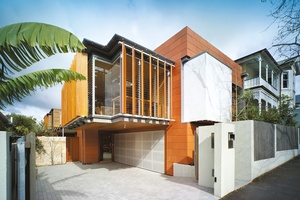
Over your career in Auckland, the size of sections has shrunk, and the ways you can use them have become more circumscribed.
It is a challenge. You’re not using the quarter acre section or whatever, where there’s a bit of ground and trees … You’ve got this tight little site, and you have to decide how much to use and how much are you allowed to use.
It’s a tough call but it does have a beautiful model. In the early fifties, Tony Mullan of Rigby Mullan did a house for himself in St Paul’s Street, off Symonds Street in the city. It later became the firm’s offices. But when it was Tony Mullan’s house, there was a carpark underneath, a courtyard in the middle … In the back of my mind, I always knew that an urban house had been done properly before in this city. When I went and looked at the original drawings of the house I was really pleased to see how relevant the ideas of Mullan were in relationship to what I’ve been trying to do. So there is a history of the urban house being done properly but it has been diluted by town planning law and by various figures involved in preservation. They didn’t give a damn about pulling Tony Mullan’s house down [in 1987] and that was a damn sight more valuable than some of these terrible bloody things now that are being replaced.
In the previous issue of Houses NZ [Auckland architect] Geoff Richards regretted the increasing amount of an architect’s time now spent on consents, hearings, and council requirements – all the bureaucratic processes of modern architecture.
Well, it’s such a burden on the cost of a building. You’re not just dealing with a council’s planning requirements – there are the building requirements as well. It’s as if architects hadn’t been dealing with them all their bloody lives … It’s not like you’re dealing with new ideas here … and yet we’ve got to go through the same processes as if we’re all cowboys.
But, for you, architecture is still an enjoyable life?
There’s not a day that I don’t get up wanting to do architecture. If I didn’t enjoy it, I’d stop, it’s as simple as that. Even when I have my holidays I just look at buildings all the time. I’m not just interested in architecture as a job – I’m interested in its role in a society and as an art form. And I also teach. I’ve always taught and I find that the teaching skills I have really come from visiting buildings and knowing buildings and talking about them, rather than from books.
What’s the size of your practice now?
It’s always about the same. We never go below 14 and never go above 16, we always try and keep it in that range. That’s about three staff per partner. Beyond that, you have to administer differently, and keeping control of projects becomes more difficult.
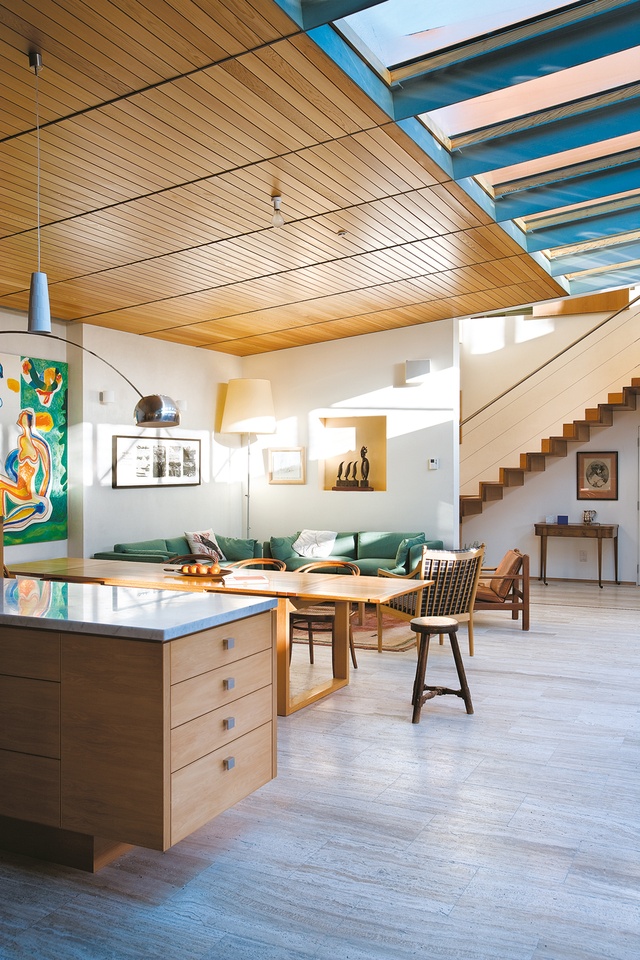
Who are your clients?
It’s a mix. We do houses for children of people we’ve done houses for … Mostly clients come from other buildings. Much of our work is a product of continuing relationships.
Are there particular houses that are important in the sense that they either marked a departure for you or expressed the design philosophy of your practice at a particular point in time?
It’s more a case of one house leading to another, one set of ideas leading to the next – a continuing evolution rather than revolutionary discoveries. There have been no great changes in the time I’ve been designing houses. If anything what I notice in my own experience is that there’s a difference between a child’s house and a teenager’s house and the two have become even more different. It’s not just about children growing up. It’s about society changing. There’s a need for a different relationship between children and the house … We always designed our houses to ensure that the children had to encounter the parents and the friends of the parents and the parents had to encounter the children and their friends. There was always some knowledge of who was in the house and what was going on. Planning for that was always a noticeable part of our larger houses.
You’ve really got to ask yourself how you can plan for changes in the ways that children and teenagers and adults use houses. There tends to be more insularity in our lives now, less interest in communal activities, or time for them. Some of it has to do with technology – with the computers, computer games, TVs in many rooms, mobile phones and texting… How you design a house around these private or anti-social pursuits has become an important part of what we do.
A Memorial will be held on Friday, October 6th 2023, at 2.00 p.m. at The Royal New Zealand Yacht Squadron, Auckland.

